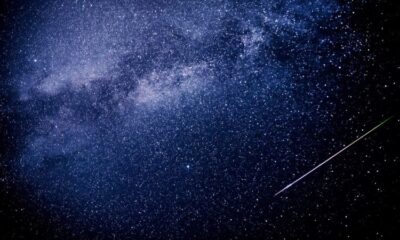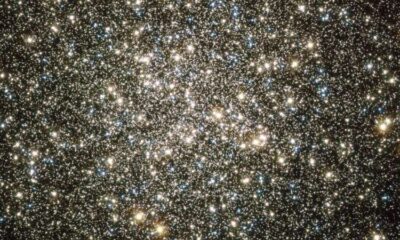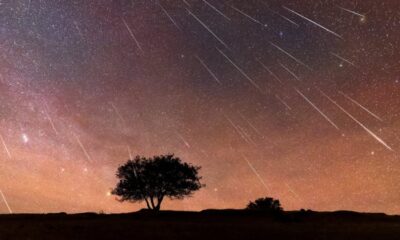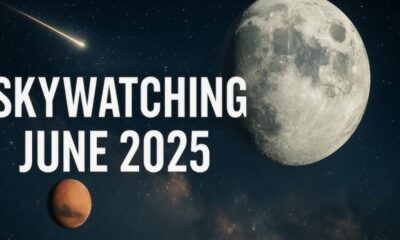Science
Things to Know about the Perseid Meteor Shower, Summer ‘Shooting Star’ Season 2025
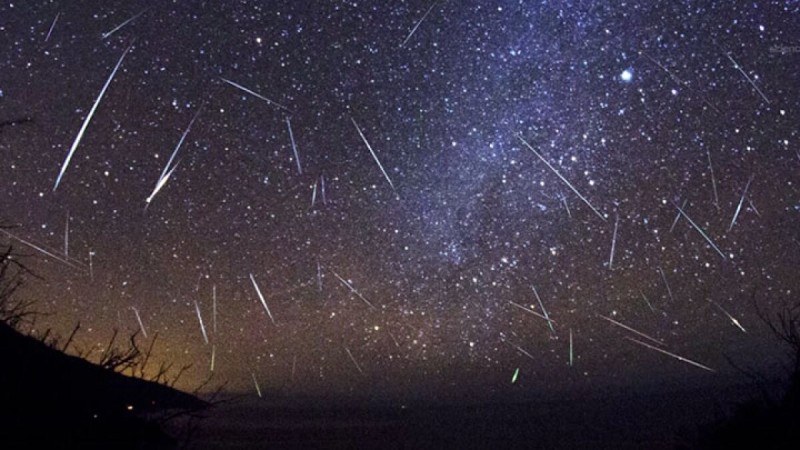
Amateur astronomers from all over the world eagerly await the renowned Perseid meteor shower every summer, but they sometimes fail to notice four lesser showers that peak between July 29 and August 16.
Why not try to see the other four, all but one of which will have gloomy skies, as this year’s Perseid meteor shower will be severely hampered by a waning gibbous moon three days past full moon phase?
Between early July and the latter week of August, summertime meteors are particularly visible, occasionally darting across your field of vision. Additionally, in addition to the Perseids, there are at least four other lesser displays that are active from August 3 to August 15.
When will the Perseid meteor shower take place in 2025?
NASA and the nonprofit American Meteor Society said the shower will start Thursday, July 17, and last for many weeks, until at least Aug. 23.
Although meteor sight will be impacted by moonlight, the meteor shower is predicted to peak between August 12 and 13. At its zenith, the moon will be 84% full.
Where and how to view the Perseids
According to NASA, the Northern Hemisphere’s greatest time to see the Perseids is in the early morning, just before sunrise. However, the meteors can occasionally be observed as early as 10 p.m.
Where and when is the best time to watch it?
One of the most spectacular summer events occurs from late July to late August. The Perseids started to show on July 17 and will continue to do so until August 23. A meteor may occasionally be visible throughout this month-long show. On August 12 and 13, when demand is at its highest, there is a potential of 25 per hour.
The difficulty is that this year’s peak of the Perseid Meteor Shower will fall during a nearly full moon. On the morning of August 9, the full moon will occur, and the brilliant night sky will wash away some of the meteors.
To get the best views, you should still seek out a dark spot with a clear view of the night sky, albeit that will create some challenges. It is better to look for the radiant of the meteor shower.
A few “shooting stars” are likely to be seen by anyone who spends even a little amount of time looking up in the night sky these days. The second half of the year typically sees higher meteoric activity on Earth. Additionally, compared to the evening, you are more likely to witness twice as many meteors each hour during the predawn hours. This is because of our orbital motion through space, which places us on the “trailing” side of Earth during the pre-midnight hours.
Therefore, to “catch” us, a meteoric particle usually needs to have an orbital velocity higher than Earth’s. However, any particle that is along Earth’s orbital path will enter our atmosphere as a meteor after midnight, when we are turned onto the “leading” side of the planet.
When these objects strike our atmosphere at 7 to 45 miles (11 to 72 km) per second, their motion energy quickly dissipates as heat, light, and ionization, producing brief light streaks that are often known as “shooting stars.”
Your eyes and a little patience will be your only equipment. The sky conditions have a significant impact on how many meteors a single observer may actually see in an hour.
The rates in the table assume that the radiant is directly overhead and that you are an experienced observer with the ability to see stars as dim as magnitude +6.5, which is thought to be the threshold of sight for the naked eye. When depicted on a star chart, the radiant is the location in the sky where the paths of shower members would intersect if extended backward. Roughly 10 degrees in the sky is equivalent to your clenched fist held at arm’s length. The hourly rate is therefore cut in half at 30 degrees (“three-fists”) above the horizon, and a third at 15 degrees.
The constellation of Cygnus, from whence these meteors seem to dart, is high overhead at around 10:30 p.m., making it ideally positioned for seeing all night long. This makes the Kappa Cygnids the most advantageous of the four minor showers that will be active in the upcoming weeks for watchers in the north. The area surrounding the constellations of Capricornus and Aquarius is the source of two of the additional showers mentioned. Around 1:30 to 2:30 a.m. local daylight time is when these constellations are at their brightest in the southern sky right now.
Overall, the four minor meteor streams offer a vast array of meteors with varying colors, speeds, and trajectories, even if their hourly rates are just a small portion of the total numbers generated by the Perseids.
These four are listed in the table below:
Minor summer meteor showers
| Shower name | Period of visibility | Peak date | Hourly rate | Remarks |
|---|---|---|---|---|
| Delta Aquarids | July 12 – Aug. 23 | July 29-31 | 25 | Swift, faint, yellow-white. |
| Alpha Capricornid | July 3 – Aug. 15 | July 31 | 5 | Slow, bright, a few fireballs. |
| Eta Eridanids | July 31 – Aug. 19 | Aug. 7 | 3 | Moderately bright, swift speed |
| Kappa Cygnids | Aug. 3 – Aug. 28 | Aug. 16 | 3 | Slow moving, sometimes flaring fireballs |
The Delta Aquarids, which have a broad three-day maximum from July 29 to July 31, are the first of our showers. However, activity has been observed from July 12 to August 23. It appears that we are witnessing two separate streams of celestial debris burning up in Earth’s atmosphere because this shower is actually made up of two radiants, one to the north and one to the south. This shower produces up to two dozen quick, weak meteors per hour.
When the double radiant crosses the meridian at around 2:30 a.m., it is well out of the frame, indicating good viewing conditions throughout the morning. This is because the moon will be in its waxing crescent phase during the period of peak activity and will set long before midnight.
Comet 96P/Machholz is thought to be the source of the space debris fragments that combine with our atmosphere to form the southern Delta Aquariids. About once every five years, this comet with a short-period comet orbits the sun. The late Donald Machholz made the discovery of Comet Machholz in 1986.
The Alpha Capricornid shower, which starts around July 3 and peaks on July 31 before ending on August 15, is a far weaker rain. This stream is well-presented this year and coincides with the apex of the Delta Aquarids, as the moonset occurs around 11:00 p.m. on the evening of July 30 and the radiant crosses the meridian at 1:30 a.m.
The Alpha Capricornids often generate brilliant yellow fireballs that can be rather impressive, even though they only average about five per hour. The comet 169P/NEAT, whose path Earth intersects at this time every year, is responsible for these meteors.
The Eta Eridanids, which have detectable members from July 31 to August 19, are the final minor shower before the Perseids. Due to the radiant’s ascent in the southeast, the moon won’t set until 3:30 a.m. on August 7, when activity is at its most. Dawn will arrive an hour later, giving little time for observation. In ideal circumstances, just roughly three members are seen every hour.
These meteors seem to be connected to a dust trail left by a weak comet traveling in a parabolic orbit, which was seen by French astronomer Jean Chacornac using telescopes between May and June 1852.
On August 12, morning skies will be dominated by a declining gibbous moon, which is 19 days old, spoiling the Perseids. The radiant rises in the evening and reaches 70 degrees in the north-northeast at the break of dawn, close to the well-known Double Star Cluster of Perseus. Although higher rates have occasionally been observed, this rich stream averages over 90 members per hour when maximum occurs under a dark sky. Only the brightest of these meteors will be visible in 2025; however, several flaring meteors with trains can be seen in clear skies. Typically, this shower lasts from July 17 until August 24.
The Kappa Cygnids are the final summer shower, with the Orionids following in the latter part of October. This shower peaks on August 16 and has restrictions from August 3 to August 28. The stream does offer flashing fireballs, and the attentive observer may be well rewarded for the time spent, even though the maximum is only three per hour. The declining crescent moon, which is 24 days old, will rise at 11:45 p.m., but the best time to take this shower is before midnight.
-

 Business1 week ago
Business1 week agoRandy NG: Inside the Process of Managing End-to-End International Trade Operations
-

 Cryptocurrency2 weeks ago
Cryptocurrency2 weeks agoRami Beracha Asks, Can Israel Become A Global Leader In Blockchain Innovation?
-

 Business2 weeks ago
Business2 weeks agoArdavon Moayer Explains How Discipline and Teamwork Translate to Sales Wins
-

 Tech4 weeks ago
Tech4 weeks agoAdsPower Promo Code for 50% Off – Ultimate Guide to AdsPower Benefits (Referral Code Included)
-

 Education3 weeks ago
Education3 weeks agoForged in Fire: Nicholas Lawless Unveils Lawless Leadership – The Model Built for a World That Traditional Leadership Can’t Survive
-

 Business3 weeks ago
Business3 weeks agoOPO Group LTD Strengthens Its Global Footprint With Expanding Offices and a Modernized Trading Ecosystem
-

 Tech1 week ago
Tech1 week agoFrontier Galvanizing: The Critical Role Of Galvanizing In Renewable Energy And Utility Projects
-

 Business4 weeks ago
Business4 weeks agoThe overlooked costs of working from home

